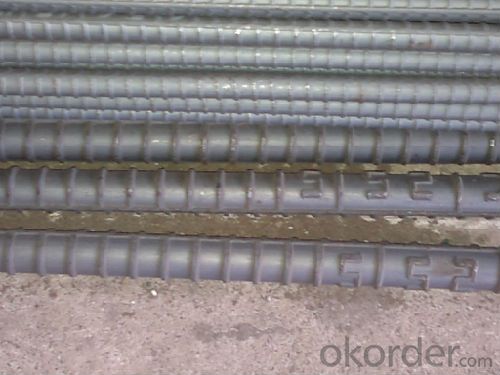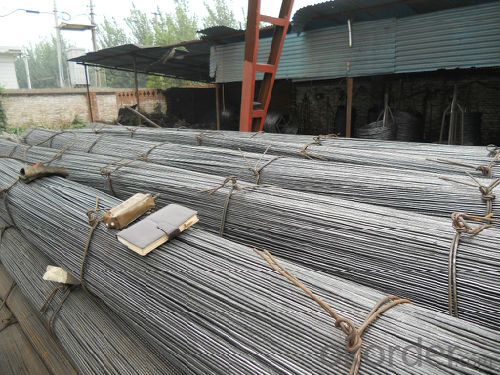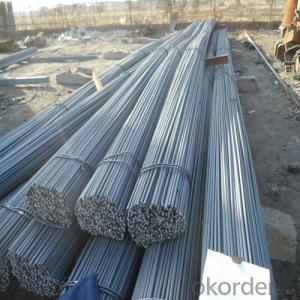Deformed Steel Bar Reinforced Deformed Steel Bar HRB400
- Loading Port:
- Tianjin
- Payment Terms:
- TT or LC
- Min Order Qty:
- 50 m.t.
- Supply Capability:
- 50000 m.t./month
OKorder Service Pledge
OKorder Financial Service
You Might Also Like
Product Description:
OKorder is offeringDeformed Steel Bar Reinforced Deformed Steel Bar HRB400 at great prices with worldwide shipping. Our supplier is a world-class manufacturer of steel, with our products utilized the world over. OKorder annually supplies products to European, North American and Asian markets. We provide quotations within 24 hours of receiving an inquiry and guarantee competitive prices.
Product Applications:
Deformed Steel Bar Reinforced Deformed Steel Bar HRB400 are ideal for structural applications and are widely used in the construction of buildings and bridges, and the manufacturing, petrochemical, and transportation industries.
Product Advantages:
OKorder's Deformed Steel Bar Reinforced Deformed Steel Bar HRB400 are durable, strong, and resist corrosion.
Main Product Features:
· Premium quality
· Prompt delivery & seaworthy packing (30 days after receiving deposit)
· Corrosion resistance
· Can be recycled and reused
· Mill test certification
· Professional Service
· Competitive pricing
Product Specifications:
Standard | GB | HRB400 | |
Diameter | 6mm,8mm,10mm,12mm,14mm,16mm,18mm,20mm, 22mm,25mm,28mm,32mm,36mm,40mm,50mm | ||
Length | 6M, 9M,12M or as required | ||
Place of origin | Hebei, China mainland | ||
Advantages | exact size, regular package, chemical and mechanical properties are stable. | ||
Type | Hot rolled deformed steel bar | ||
Brand name | DRAGON | ||
Chemical Composition: (Please kindly find our chemistry of our material based on HRB500 as below for your information)
Grade | Technical data of the original chemical composition (%) | ||||||
C | Mn | Si | S | P | V | ||
HRB400 | ≤0.25 | ≤1.60 | ≤0.80 | ≤0.045 | ≤0.045 | 0.04-0.12 | |
Physical capability | |||||||
Yield Strength (N/cm²) | Tensile Strength (N/cm²) | Elongation (%) | |||||
≥400 | ≥570 | ≥14 | |||||
Theoretical weight and section area of each diameter as below for your information:
Diameter(mm) | Section area (mm²) | Mass(kg/m) | Weight of 12m bar(kg) |
6 | 28.27 | 0.222 | 2.664 |
8 | 50.27 | 0.395 | 4.74 |
10 | 78.54 | 0.617 | 7.404 |
12 | 113.1 | 0.888 | 10.656 |
14 | 153.9 | 1.21 | 14.52 |
16 | 201.1 | 1.58 | 18.96 |
18 | 254.5 | 2.00 | 24 |
20 | 314.2 | 2.47 | 29.64 |
22 | 380.1 | 2.98 | 35.76 |
25 | 490.9 | 3.85 | 46.2 |
28 | 615.8 | 4.83 | 57.96 |
32 | 804.2 | 6.31 | 75.72 |
36 | 1018 | 7.99 | 98.88 |
40 | 1257 | 9.87 | 118.44 |
50 | 1964 | 15.42 | 185.04 |
Usage and Applications of HRB400 Deformed Steel Bar:
Deformed bar is widely used in buildings, bridges, roads and other engineering construction. Big to highways, railways, bridges, culverts, tunnels, public facilities such as flood control, dam, small to housing construction, beam, column, wall and the foundation of the plate, deformed bar is an integral structure material. With the development of world economy and the vigorous development of infrastructure construction, real estate, the demand for deformed bar will be larger and larger..
Packaging & Delivery of HRB400 Deformed Steel Bar:
Packaging Detail: products are packed in bundle and then shipped by container or bulk vessel, deformed bar is usually naked strapping delivery, when storing, please pay attention to moisture proof. The performance of rust will produce adverse effect.
Each bundle weight: 2-3MT, or as required
Payment term: TT or L/C
Delivery Detail: within 45 days after received advanced payment or LC.
Label: to be specified by customer, generally, each bundle has 1-2 labels
Trade terms: FOB, CFR, CIF
FAQ:
Q1: Why buy Materials & Equipment from OKorder.com?
A1: All products offered byOKorder.com are carefully selected from China's most reliable manufacturing enterprises. Through its ISO certifications, OKorder.com adheres to the highest standards and a commitment to supply chain safety and customer satisfaction.
Q2: How do we guarantee the quality of our products?
A2: We have established an advanced quality management system which conducts strict quality tests at every step, from raw materials to the final product. At the same time, we provide extensive follow-up service assurances as required.
Q3: How soon can we receive the product after purchase?
A3: Within three days of placing an order, we will begin production. The specific shipping date is dependent upon international and government factors, but is typically 7 to 10 workdays.
Images:



- Q:How are steel rebars protected during construction?
- Steel rebars are protected during construction through a variety of methods to ensure their longevity and structural integrity. One common method is the use of epoxy coatings or corrosion-resistant paints. These coatings create a barrier between the steel rebar and the external environment, preventing moisture, chemicals, and other corrosive substances from reaching the surface of the steel. Another way rebars are protected is by placing them at the correct depth within the concrete. By ensuring that the rebars are embedded within the concrete at the specified depth, they are shielded from exposure to external elements that could potentially cause corrosion. Additionally, rebars can be protected through the use of concrete covers. Concrete covers are layers of concrete that are placed around the rebars, acting as a physical barrier against external factors. The thickness of the concrete cover is determined based on the environmental conditions and design requirements of the specific construction project. Furthermore, rebars can be protected by implementing proper drainage systems to prevent the accumulation of water around the steel. By ensuring that water is effectively drained away from the rebars, the risk of corrosion is significantly reduced. Regular inspections and maintenance are also crucial in protecting steel rebars during construction. Any signs of corrosion or damage should be promptly addressed and repaired to prevent further degradation. Overall, a combination of epoxy coatings, correct placement within the concrete, concrete covers, drainage systems, and regular maintenance are essential in protecting steel rebars during construction, ensuring their durability and structural integrity for years to come.
- Q:How do steel rebars affect the load-bearing capacity of concrete structures?
- Steel rebars significantly enhance the load-bearing capacity of concrete structures by providing tensile strength to resist cracks and prevent failure under heavy loads. The incorporation of rebars in concrete increases its overall structural integrity, allowing it to withstand greater stress and support larger loads without compromising its stability.
- Q:How do steel rebars comply with building codes and regulations?
- Steel rebars comply with building codes and regulations by meeting the specific requirements outlined for their use in construction projects. Building codes and regulations are established to ensure the safety, durability, and structural integrity of buildings. Here are a few ways steel rebars comply with these codes and regulations: 1. Material Standards: Steel rebars must meet certain material standards set by the building codes. These standards specify the type, grade, and quality of steel allowed for construction purposes. For example, the American Society for Testing and Materials (ASTM) has established standards for steel rebars, such as ASTM A615, which outlines the requirements for deformed and plain carbon-steel bars. 2. Size and Shape: Building codes specify the dimensions and shape of rebars to be used in different structural elements, such as beams, columns, and slabs. Steel rebars must comply with these size and shape requirements to ensure proper fit and structural integrity. 3. Placement and Spacing: Building codes dictate the proper placement and spacing of rebars within concrete structures. These codes specify the minimum and maximum distances between rebars, as well as the cover requirements (distance from the surface of the concrete). Compliance with these regulations helps enhance the strength and durability of the structure. 4. Welding and Connection: If welding or connecting rebars is necessary, building codes provide guidelines on the proper welding techniques and requirements. These regulations ensure that the welded or connected rebars provide the necessary strength and stability to the structure. 5. Testing and Certification: Steel rebars need to undergo various tests to ensure compliance with building codes and regulations. These tests include tensile strength, yield strength, elongation, and bending tests. Products that pass these tests are certified as compliant and can be used in construction projects. By adhering to these building codes and regulations, steel rebars contribute to the overall safety and integrity of the structures they are used in. Compliance ensures that the rebars meet the necessary standards and perform their intended function effectively.
- Q:Can steel rebars be used in wind turbine tower construction?
- Steel rebars are indeed utilized in the construction of wind turbine towers. In the construction industry, steel rebars are frequently employed to reinforce concrete structures. Wind turbine towers typically consist of reinforced concrete for both the foundation and the tower structure. By integrating steel rebars, the concrete's strength and durability are enhanced, enabling it to withstand the wind turbine's exerted loads and forces. The rebars effectively reinforce the concrete, ensuring the even distribution of loads throughout the tower structure, thereby guaranteeing its stability and structural integrity. Consequently, steel rebars hold significant importance in wind turbine tower construction and are commonly employed in this particular application.
- Q:What is the best way to store steel rebars on site?
- The best way to store steel rebars on site is to stack them off the ground on a flat, level surface. They should be stored in an upright position, vertically aligned, and separated by appropriate spacers to prevent any contact or tangling. Additionally, covering them with a protective tarp or material can help shield them from moisture and other elements that may cause corrosion.
- Q:Can steel rebars be used in parking structures?
- Yes, steel rebars are commonly used in parking structures for reinforcing concrete and enhancing the structural integrity of the building.
- Q:What is the resistance of steel rebars against acid attacks?
- Steel rebars have a high resistance against acid attacks due to the protective layer of rust that forms on their surface. This layer, known as iron oxide, acts as a barrier between the steel and the acid, preventing direct contact and corrosion. Additionally, the high carbon content in steel rebars enhances their resistance to acid attacks, as carbon forms a protective film that further shields the steel from acid damage. However, it is important to note that prolonged exposure to highly concentrated or corrosive acids may still lead to some degree of corrosion, albeit at a slower rate compared to other metals. Therefore, it is advisable to select the appropriate grade of steel rebar and provide additional protective measures, such as coatings or concrete cover, to ensure optimal resistance against acid attacks in specific applications.
- Q:How do steel rebars affect the thermal properties of concrete?
- The thermal properties of concrete can be affected in both positive and negative ways by the presence of steel rebars. On the positive side, steel rebars can enhance the overall thermal conductivity of the concrete, enabling more efficient heat transfer and distribution within the structure. This can be advantageous in situations where thermal conductivity is desirable, such as in buildings with radiant heating systems. However, there is a discrepancy in the thermal expansion and contraction characteristics between steel and concrete. This dissimilarity in thermal expansion coefficients can result in the formation of thermal stresses and potential cracks within the concrete, particularly during temperature fluctuations. These cracks have the potential to compromise the structural integrity of the concrete and may necessitate additional reinforcement measures to mitigate their effects. In summary, the inclusion of steel rebars can influence the thermal properties of concrete by augmenting its thermal conductivity and potentially giving rise to thermal stresses and cracks. It is crucial to take these factors into account during the design and construction stages to ensure the desired performance and durability of the concrete structure.
- Q:Can steel rebars be used in structures with limited maintenance access?
- Yes, steel rebars can be used in structures with limited maintenance access. Steel rebars are commonly used in construction due to their durability and strength. They can withstand various environmental conditions and require minimal maintenance. Additionally, their flexible and versatile nature allows them to be easily integrated into structures with limited maintenance access, making them a suitable choice for such projects.
- Q:How are steel rebars classified based on their shape?
- There are several types of steel rebars that are classified according to their shape. The most commonly used ones include plain round bars, deformed bars, square bars, and ribbed bars. Plain round bars are the simplest and most frequently utilized type. They have a smooth and round surface without any deformations or ribs. These bars are typically employed in cases where minimal reinforcement is needed for the concrete structure. Deformed bars, on the other hand, have ribs or deformations along their length. These ribs enhance the bond between the steel and the concrete, thereby improving structural integrity and preventing slippage. Deformed bars can be further classified based on the pattern and profile of the ribs, such as deformed high yield bars, twisted bars, and TMT (Thermo-Mechanically Treated) bars. Square bars, as their name suggests, have a square cross-section. They are mainly used in situations where additional strength and rigidity are required. Square rebars distribute loads better and are commonly utilized in building foundations, columns, and beams. Ribbed bars, also known as deformed square bars, have a square cross-section with ribs or deformations along their length. These ribs enhance the bond between the steel and the concrete, thereby providing better resistance against shear forces and improving overall structural strength. Ribbed bars are frequently used in reinforced concrete structures, such as bridges, highways, and buildings. To summarize, steel rebars are classified based on their shape into plain round bars, deformed bars, square bars, and ribbed bars. Each type of rebar offers distinct characteristics and is chosen based on the specific requirements and load-bearing capacity of the concrete structure.
1. Manufacturer Overview |
|
|---|---|
| Location | |
| Year Established | |
| Annual Output Value | |
| Main Markets | |
| Company Certifications | |
2. Manufacturer Certificates |
|
|---|---|
| a) Certification Name | |
| Range | |
| Reference | |
| Validity Period | |
3. Manufacturer Capability |
|
|---|---|
| a)Trade Capacity | |
| Nearest Port | |
| Export Percentage | |
| No.of Employees in Trade Department | |
| Language Spoken: | |
| b)Factory Information | |
| Factory Size: | |
| No. of Production Lines | |
| Contract Manufacturing | |
| Product Price Range | |
Send your message to us
Deformed Steel Bar Reinforced Deformed Steel Bar HRB400
- Loading Port:
- Tianjin
- Payment Terms:
- TT or LC
- Min Order Qty:
- 50 m.t.
- Supply Capability:
- 50000 m.t./month
OKorder Service Pledge
OKorder Financial Service
Similar products
New products
Hot products
Related keywords





























